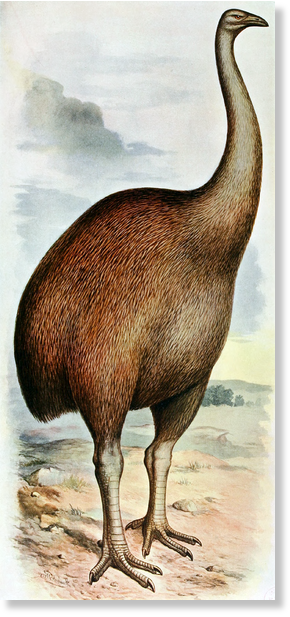
© Frederick William FrohawkExtinct North Island giant moa
MÄori Studies staff and students from Victoria University of Wellington have excavated hundreds of moa bones from a central North Island site where few moa remains were known to exist.
The rare discovery was part of a field trip dubbed 'Operation Moa Hunt' in April, run by Victoria's Te Kawa a MÄui, School of MÄori Studies.
The bones belong to about 50 individual moa birds and were excavated from an area 3m2 and 50cm deep, on a farm south of Taihape.
Initial identifications indicate the bones come from mainly two moa species, the North Island giant moa and the little bush moa,
and are at least 1800 years old.The School's Kairuruku/Research Associate Dr Bruce McFadgen and Ahonuku/Associate Professor Peter Adds, both trained archaeologists, led the students on the weekend-long field trip, along with Te Papa Vertebrate Curator Alan Tennyson.
Mr Tennyson says the find has tripled the number of moa bones found on the volcanic plateau held in public museums.
He says the discoveries help us understand where different moa species were found, and the time periods over which they were present in the area.
Dr McFadgen says: "It looks like the bones have accumulated over a fairly long time,
but the strange thing is, it's a lot of birds in a very concentrated area."We don't know for sure why moa were drawn to that particular spot. One theory is they entered the swamp because they were attracted to food, such as fruit. The birds got stuck and drowned," he says.
Mr Adds says while the bones are in a reasonable condition, many are decayed and there are no complete skeletons. The noticeable lack of skulls suggests the more delicate bones may have rotted away, he says.
The School has scheduled a second field trip for students later this month to complete the site excavation and sample other nearby areas.
Mr Tennyson says the bones are a valuable addition to Te Papa's permanent research collections, which currently do not include moa bones from the volcanic plateau.

Reader Comments
to our Newsletter